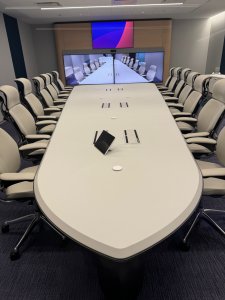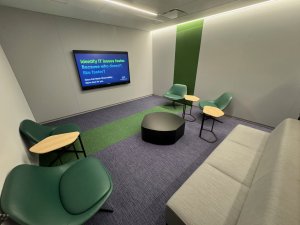Return to office initiatives are in the news more and more lately, but is mandating employees to return the best approach? Cisco CEO Chuck Robbins is taking a different approach, instead of a mandate, Cisco has reimagined its offices to make them a magnet for employees to return. I was able to tour their offices at Penn1 in NYC recently to better understand what that entails.
The pandemic created an unparalleled opportunity for employees to work from home or remote locations. However, with the pandemic in the rearview, many businesses are now implementing ‘return to office’ mandates that require employees to be in the office at least a couple of days per week, but have the businesses adjusted their campus environments to accommodate this return and created an enticing environment so they can collaborate and be productive? Keep in mind that working from home today is very different than during the pandemic when everyone in the family was home and vying for internet bandwidth. Now with kids back in school hybrid workers typically enjoy 1Gb connections, multiscreen setups, and a quiet workspace.
To get a feel for what is possible in the office, I recently visited the Cisco campus on the ninth floor at Penn1, NYC, NY. This work environment was completely reimagined to support CEO Chuck Robbins’ mantra of “make the office a magnet, not a mandate.” Many thanks to Cornell Nelson and Bob Cicero of Cisco for setting up and conducting the tour of the facility. Going in, I expected to hear about enhanced Wi-Fi 6/6e/7 and maybe some info about collaboration technologies, but what I saw was so much more, as this reimagined office space goes far beyond what I thought was possible.
The entire space was renovated with several goals in mind. These included taking a technology first, not last mindset, incorporating sustainability (Cisco has a net zero emissions goal for 2040) ensuring the health and wellness of its employees and lastly, digitally transforming and driving the convergence of IT and real estate (ITRE) to ensure the best possible experiences. To do this organizations must:
- Understand how space will be used and determine what technology is needed first. According to Cisco, employees returning to the office are doing so for four main reasons, to brainstorm, to learn/get training, to socialize, and to collaborate. As a result, organizations need to build out the office space accordingly. In Cisco’s case, this meant transitioning from 70% offices and cubicles and 30% meeting/training rooms to 80% collaborative/training space and 20% individual desk space which included eliminating all individual offices. Then, based on what each space would be used for (according to the four above), they would decide what technology would be required, i.e. whiteboards, multi-vendor meeting platforms (Webex, Zoom, Teams), video screens, sound (you have to experience the cone of sound if you take a tour to believe it), etc. From a technology experience perspective, it should be noted that all Cisco employees have Cisco collaboration endpoints at home, and in the Cisco office there are 92 of these devices of varying sizes, in every room, on every desk, and even in gathering/public spaces and hallways that all work the same way. These endpoint devices have embedded Nvidia GPUs, Sensors, Cameras, and a Cisco software stack, with the software stack enabling continuous innovation and eliminating the need for additional devices and software. Training rooms are now smaller for in-person training but enhanced for remote learning. They leverage technology that has cameras that follow not only the presenter but also those in-person attendees asking questions to ensure a more immersive experience for those watching remotely. As a result, the training room has a 50% – 60% occupancy rate, with all sessions being hybrid, and it was noted that this was a much higher rate than in the prior environment. Once the technology is decided, the furniture needs to be selected – for example, in brainstorming or collaboration spaces the tables have five-degree angles that serve two functions, one they appear square on the video and two ensure all participants can be seen. Or conference tables with the same angles so when connecting to another office with the same table so it appears as though they are all sitting at the same table. And there is more to come with the campfire and cinematic technology harnessing AI that is currently being developed.

In collaboration spaces, the furniture could be far more casual with couches and comfortable chairs – spoiler alert, these are the spaces that are highly requested. It should be noted that even the carpet and paint can serve a purpose, as an indicator of when they are on camera and when they are not. A green line designates when someone will be on camera vs not. This also highlights the need to integrate technology into the design. Lastly, once these things have been determined, then the physical walls can be constructed around the space if required.

- Create a more sustainable office environment. Given Cisco’s commitment to have net zero emissions by 2040, the team investigated how to drive down power requirements. This included replacing traditional copper electrical wiring with power over ethernet (PoE) which is capable of supporting 90W per port. This had several impacts, first, it eliminated over 3000 pounds of steel and 1000 pounds of copper from pipes, conduit, and wiring, secondly, this enabled Cisco to switch to low-voltage lighting, shade motors, and HVAC controls. This even extends to low power height adjustable desks, charging ports, and workstations (which also drives flexibility and only requires 3 PoE cables – Atlanta has 102 connected in this fashion). As a result of these changes, the company was able to take out 36% of emissions as compared to the prior environment. Instead of all those copper wires, an approximately 3-inch bundle of PoE cable provides power to a 12,000 sq ft area. In addition to these savings, it also provides the advantage of the network being the electric meter – which gives Cisco or real estate facilities greater control and visibility into the power being used, down to a tenth of a Watt, for what and when. As a result of the sensors embedded in the Cisco endpoint devices, changes can be automatically made to adjust lighting, temperature, and shades in any area where an endpoint is located. Plus, Cisco is experimenting with rolls of solar panels to potentially add to the window side of the shades to leverage solar power to further reduce power consumption from the grid.
- Prioritize the health and wellness of your employees. Cisco uses the WellCertified criteria (WELL – International WELL Building Institute | IWBI (wellcertified.com) to ensure its offices maximize daylight, provide thermal comfort, and are safe for employees. Much of this is enabled by the sensors deployed in every Cisco device, in addition to the cameras, every device also monitors temperature, humidity, ambient noise, and volatile organic compounds of VOCs. Based on this data, shades can be automatically raised or lowered, temperature can be adjusted based on the number of people in a room. For example, if ten people are in a meeting room, the Cisco software will automatically adjust the temp to keep everyone cool. When the sun starts to heat up a room, the shades can automatically be lowered.
- Digitize the office space. While many other areas of business have been digitized, the facilities and real estate space are still fairly nascent. Given the growing importance of leveraging data to make decisions, the ability to instrument and collect information in the office is important. As mentioned in the technology section, Cisco has sensors integrated into all its endpoint devices in its campus environment. At the Penn1 location they collect over 5,000 data points from these endpoints and Meraki cameras. Armed with this information, organizations can better understand how all the different spaces are used. For example, when Cisco built out this environment, they believed that meeting rooms would be used by 3 people the majority of the time. What they found was that these rooms were used 66% of the time by only one person, 14% of the time by two people, and only 4.5% of the time by three people. This data also enables Cisco to track office and room occupancy – showing information like the average number of visits, length of visit, and which days are most popular to be in the office – no surprise that Wednesday is the busiest day in the office. The data also highlighted the discrepancy between booked rooms (80%) and used rooms (50%). As a result, meeting spaces are now reserved when needed and if they are not occupied within three minutes, they revert to being open. Conversely, if an open room becomes occupied, it shows itself as being in use and unavailable to be reserved. In public spaces, the office layout is displayed for all to see.
Reimagining your campus environment
As organizations look to bring employees back to the office, it will be imperative to ensure they have a positive experience, can collaborate, and be productive. Cisco has taken the approach that businesses need to create an environment that pulls employees back in. Chuck Robbins’ mantra of making the office a magnet has been realized at Penn1 from what I have seen. And it’s not the only one, Atlanta and Paris are now open, and Cisco is in the process of creating another 29 reimagined offices globally. Forcing employees to return to an outdated office environment will only create discontent in the workforce. As Bob Cicero put it, “People work from home in the 21st-century (smart lights, smart thermostats, etc.) and return to office mandates are forcing them to work in 20th-century environments”(manual lights, manual thermostats, etc.)
Ultimately this is about ensuring that your employees have a consistent and positive experience when they return to the office. To help other organizations achieve this goal, Cisco offers 16 different design guides and has hosted over 1,500 tours at the New York and Atlanta locations to date to help organizations understand what is possible and how to accelerate the transformation. I highly recommend that you take a tour because as much as I have tried to describe it, you need to experience it in person to get the full effect of what has been accomplished and what is possible.

